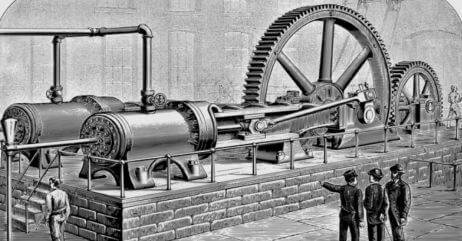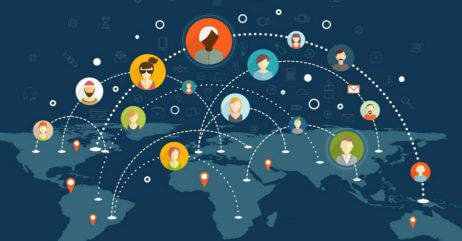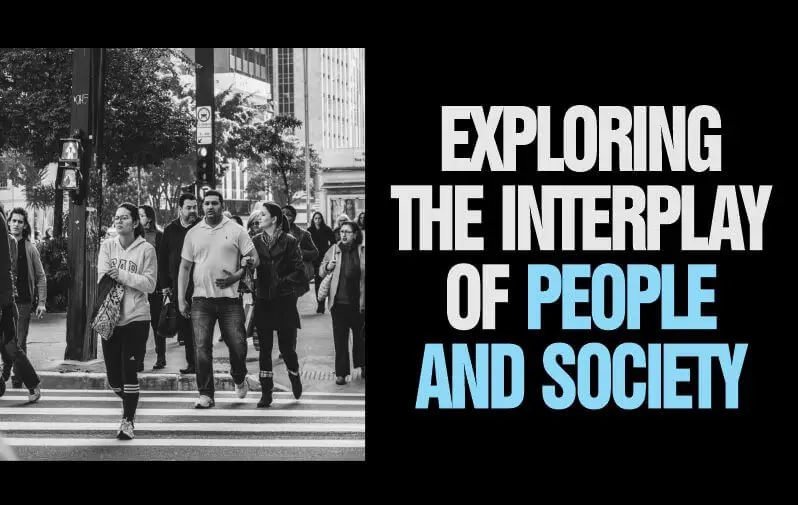Last updated on April 27th, 2024 at 05:44 am
People and society are inseparable entities that have been intricately connected throughout history and continue to evolve.
When I study people and society, I am baffled by how man transformed from being in the wild to what we have today as a complex society.
Society, made up of individuals of diverse backgrounds, beliefs, and aspirations, forms the base upon which human lives are built and navigate their interactions.
Understanding the dynamics between people and society is essential for comprehending the complexities of human existence and promoting harmonious coexistence.
From the evolution of early man civilizations to the present day, societies have undergone profound transformations, influencing and shaping the lives of individuals in numerous ways.
We will discuss the complex relationship between people and society, the roles individuals play, the impact of social structures, cultural diversity, social issues, and collective action, and envision a future where both people and society thrive in symbiotic harmony.
Table of Contents
- Evolution of Human Societies
- The Role of Individuals in Society
- Balancing Personal Freedom and Societal Responsibilities
- Social Structures and Institutions
- Examples of Social Institutions
- Roles of Social Structures and Institutions
- How Social Structures Shape Individuals and Society
- Cultural Diversity and Identity
- Impact of Cultural Identity on Individuals and Communities
- Challenges and Benefits of Multiculturalism
- Social Issues and Challenges
- Collective Action
- Future Perspectives
- Frequently Asked Questions
- Conclusion
Evolution of Human Societies
The evolution of human societies is a testament to our adaptability, ingenuity, and capacity for change.
From the humble beginnings of hunter-gatherer bands to the interconnected global communities of today, our social structures and ways of life have continuously evolved.
Each stage of this evolution has brought new challenges, opportunities, and complexities.
Understanding the past helps us comprehend the present and shape the future of our societies.
As we move forward, it is crucial to reflect on our collective journey and strive for inclusive, sustainable, and harmonious existence that benefits all people and society, regardless of their backgrounds or circumstances.
Here is the timeline of the evolution of people and society:
1. Hunter-Gatherer Societies

The earliest human societies were hunter-gatherer communities. These groups relied on hunting animals and gathering wild plants for survival.
They lived in small, nomadic bands and had a strong sense of communal living.
Cooperation, sharing of resources, and division of labwasere essential for their survival.
This stage lasted for thousands of years and laid the foundation for future societal developments.
Related: Individuality and Collectivism
2. Agricultural Revolution

Around 10,000 years ago, humans transitioned from a nomadic lifestyle to settled agricultural communities.
This ushered in a significant change in human history. The discovery of agriculture had people cultivate crops and domesticate animals, leading to a more stable food supply.
As a result, populations grew, and permanent settlements emerged.
The development of agriculture brought about social stratification, as some individuals specialized in farming while others engaged in other occupations.
3. Rise of Civilizations

The next major leap in human societal evolution was the rise of civilizations.
In various parts of the world, such as Mesopotamia, Egypt, the Indus Valley, and China, complex societies emerged.
These civilizations were characterized by urban centers, sophisticated governance systems, written languages, monumental architecture, and advancements in science, art, and technology.
The division of labor became more pronounced, with specialized roles in administration, trade, and craftsmanship.
4. Industrial Revolution

The Industrial Revolution, which began in the 18th century, brought about a dramatic transformation in human societies.
The invention of machinery and the shift from agrarian to industrial economies revolutionized production processes.
Urbanization was created as people moved from rural areas to cities in search of employment.
This period witnessed significant social and economic changes, including the rise of the middle class, the expansion of trade and commerce, and the emergence of new social classes.
5. Technological Advancements and Globalization

The 20th and 21st centuries have witnessed unprecedented advancements in technology, communication, and transportation, leading to the globalization of human societies.
The internet, for instance, has connected people across the globe, enabling instant communication and the exchange of ideas.
Globalization has facilitated the movement of goods, services, and people, leading to cultural exchange, interdependence, and the formation of global communities.
Related: What is Herd Mentality? How to Overcome it
The Role of Individuals in Society
The role of individuals in society is pivotal and should not be underestimated.
Each person has the power to make a difference, whether through their actions, ideas, or values.
By embracing their agency, individuals can become catalysts for change, driving progress, advocating for justice, and building stronger communities.
It is through the collective efforts of individuals that we can create a more inclusive, equitable, and compassionate world for present and future generations.
Here is a list of the roles of individuals in society:
1. Agents of Change
Wherever you find yourself, you should be an agent of change no matter the size of the society.
You have the power to be an agent of change within that small society.
History has in abundance examples of persons who have challenged the status quo, fought for justice, and brought about transformative social movements.
From Mahatma Gandhi’s nonviolent resistance to Rosa Parks’ refusal to give up her seat, these individuals have shown that one person’s actions can ignite a spark that leads to significant societal shifts.
By standing up for what they believe in, individuals can inspire others, challenge oppressive systems, and drive positive change.
Related: Understanding Gender Roles in Society
2. Innovation and Progress
Innovation and progress are often driven by the ideas and actions of individuals.
Throughout history, inventors, scientists, artists, and entrepreneurs have pushed the boundaries of knowledge and created groundbreaking advancements that have shaped society.
Think of individuals like Thomas Edison, Marie Curie, Steve Jobs, and Elon Musk, whose ideas and inventions have revolutionized technology, medicine, and the way we live.
By nurturing your creativity, pursuing your passions, and taking risks, you can contribute to the betterment of society and drive progress in various fields.
3. Community Engagement and Volunteering
Individuals play a crucial role in building strong and vibrant communities.
By actively engaging in their local communities and volunteering their time and skills, individuals can make a positive impact on the lives of others.
Whether it’s mentoring youth, organizing community events, or participating in charitable initiatives, individuals can promote a sense of belonging, social cohesion, and collective well-being.
Through their acts of kindness and service, individuals can create a ripple effect that spreads compassion and strengthens the fabric of society.
4. Advocacy and Social Justice
Individuals have the power to advocate for social justice and equality.
By raising their voices against discrimination, inequality, and injustice, individuals can bring attention to important issues and drive systemic change.
Whether it’s advocating for gender equality, racial justice, LGBTQ+ rights, or environmental sustainability, individuals can contribute to creating a more inclusive and equitable society.
Through education, awareness-raising, and grassroots activism, you too can challenge oppressive systems and work towards a fairer world for all.
5. Leading by Example
Individuals can inspire others through their actions and values.
For instance, by being empathetic, building integrity, and compassion, you can serve as role models for others to follow.
Whether it’s in your personal relationships, workplaces, or communities, you can inspire positive behaviour, promote a culture of kindness and respect, and create a ripple effect of positive change by leading by example.
By living their values and treating others with dignity and respect, you can also contribute to a more harmonious and compassionate society.
Related: The History of Gender Stereotypes in Society
Also Read: How Masculinity Affects Society
Balancing Personal Freedom and Societal Responsibilities
Balancing personal freedom and societal responsibilities is a delicate task that societies grapple with.
While personal freedom allows individuals to exercise their rights, pursue their goals, and express themselves, societal responsibilities ensure the well-being and harmony of the collective.
Here are some critical considerations for striking a balance between personal freedom and societal responsibilities:
1. Respect for Individual Rights
Personal freedom is grounded in the recognition and protection of individual rights.
Societies should uphold fundamental rights such as freedom of speech, expression, religion, and privacy.
Respecting these rights allows individuals to exercise their autonomy and pursue their own paths, contributing to personal growth and fulfillment.
2. Recognizing the Common Good
Alongside personal freedom, individuals have a responsibility to consider the common good and the well-being of the broader society.
This involves recognizing that personal actions can impact others and making choices that promote the greater good.
Balancing personal interests with the welfare of others helps maintain social harmony and promotes a sense of collective responsibility.
3. Upholding Ethical Standards
Ethical considerations play a crucial role in balancing personal freedom and societal responsibilities.
Individuals should adhere to ethical principles that guide their actions, ensuring that their exercise of personal freedom does not infringe upon the rights or well-being of others.
Ethical behavior promotes fairness, justice, and respect for others, contributing to a harmonious society.
4. Social Contract and Rule of Law
Societies establish social contracts and the rule of law to strike a balance between personal freedom and societal responsibilities.
Laws and regulations set boundaries and expectations for individual behavior, ensuring that personal freedom does not lead to harm or infringe upon the rights of others.
Individuals have a responsibility to abide by these laws, which are designed to protect the common good and maintain social order.
5. Civic Engagement and Participation
Active civic engagement and participation are essential for balancing personal freedom and societal responsibilities.
Individuals should actively contribute to their communities, participate in democratic processes, and work towards the betterment of society.
This can involve volunteering, advocating for social causes, and engaging in constructive dialogue to address societal challenges collectively.
6. Education and Awareness
Promoting education and awareness about personal rights and societal responsibilities is crucial for striking a balance.
By promoting a culture of understanding, empathy, and civic responsibility, societies can empower individuals to exercise their personal freedom responsibly and contribute positively to the well-being of society.
Balancing personal freedom and societal responsibilities is an ongoing process that requires open dialogue, compromise, and a commitment to shared values.
It is a dynamic equilibrium that evolves as societies change and adapt to new circumstances.
By recognizing the importance of both personal freedom and societal responsibilities, societies can create an environment that respects individual rights while promoting a sense of collective well-being and progress.
Recommended: The Alpha Male Archetype and its Impact on Society
Social Structures and Institutions
Social structures and institutions are fundamental components of human societies.
They provide the framework and organization for individuals to interact, establish relationships, and function within a collective group.
Social structures refer to the patterns of relationships, roles, and institutions that shape human interactions.
They provide a sense of order, stability, and predictability within society. Examples of social structures include the family, education system, government, economy, religion, and healthcare system.
Social institutions, on the other hand, are specific organizations or systems that fulfill certain functions within society.
They are formalized structures that have established rules, norms, and roles.
Social institutions serve various purposes, such as socializing individuals, maintaining order, allocating resources, and providing services.
Examples of Social Institutions
The Family as a Social Institution
The family is a primary social institution that plays a crucial role in socializing individuals, transmitting cultural values, and providing emotional support.
Education as a social institution
The education system is another important institution that imparts knowledge, skills, and values to prepare individuals for their roles in society.
The Government as a Social Institution
The government and political institutions establish laws, regulations, and governance systems to maintain order and make collective decisions.
The Economy as a Social Institution
The economy encompasses institutions such as markets, businesses, and financial systems that facilitate the production, distribution, and consumption of goods and services.
Religious Institutions as Social Institutions
Religious institutions provide a framework for spiritual beliefs, rituals, and moral values, while healthcare institutions address the well-being and medical needs of individuals within society.
These are just a few examples of social institutions, and different societies may have variations or additional institutions based on their cultural, historical, and geographical contexts.
Roles of Social Structures and Institutions
Social structures and institutions have significant functions and significance within society.
- They socialize individuals by imparting cultural values, norms, and behaviors, shaping their identities and behaviors.
- They establish rules and regulations that maintain order, stability, and social cohesion.
- Social structures also allocate roles and responsibilities, facilitating the division of labor and the efficient functioning of society.
- Institutions enforce social norms and regulations, ensuring social control and adherence to societal expectations.
Also Read: How to Use Your Social Power Responsibly
- They also contribute to social mobility by providing opportunities for individuals to improve their social and economic status.
- Social structures and institutions shape individuals and society in various ways.
- They influence identity formation, socialization, and behavior, shaping how individuals perceive themselves and interact with others.
- They can perpetuate power dynamics and inequalities within society, influencing access to resources, opportunities, and social privileges.
- Social structures also provide the context for collective action and social change, as they can be sites of resistance, activism, and social movements.
Understanding social structures and institutions helps us comprehend how they shape individuals, relationships, and the broader fabric of society.
By critically examining and adapting these structures, societies can work towards creating more inclusive, equitable, and just social systems.
How Social Structures Shape Individuals and Society
Social structures play a significant role in shaping individuals and society.
They influence how individuals perceive themselves, interact with others, and navigate their social environment.
At the same time, social structures contribute to the overall functioning and dynamics of society.
Here are some ways in which social structures shape individuals and society:
1. Identity Formation
Social structures provide individuals with roles, expectations, and cultural frameworks that shape their identities.
For example, the family structure and cultural norms within a society influence an individual’s sense of self, values, and beliefs.
Social structures contribute to the formation of personal and social identities, influencing how individuals perceive themselves and others.
2. Socialization and Behaviour
Social structures, such as the family, education system, and peer groups, play a crucial role in socializing individuals.
They teach individuals how to interact, communicate, and behave within society.
Social structures transmit cultural values, norms, and behaviors, shaping individuals’ attitudes, beliefs, and behaviours.
For instance, the education system socializes individuals by imparting knowledge, skills, and societal expectations.
Related: Understanding Power Play in Relationships
3. Power and Inequality
Social structures can perpetuate power dynamics and inequalities within society.
Institutions such as government, the economy, and social hierarchies can influence access to resources, opportunities, and social privileges.
Social structures shape social hierarchies, class divisions, and disparities in power and wealth.
They can either reinforce existing inequalities or work towards creating a more equitable society.
4. Collective Behaviour and Social Change
Social structures provide the context for collective behaviour and social change.
Institutions and social movements can challenge existing norms, policies, and power structures.
For example, social movements advocating for civil rights, gender equality, or environmental sustainability aim to reshape social structures and bring about positive change.
Social structures can either facilitate or hinder collective action and social transformation.
5. Social Order and Stability
Social structures establish rules, norms, and institutions that maintain social order and stability.
They provide a framework for resolving conflicts, enforcing regulations, and ensuring social cohesion.
Social structures contribute to the functioning of society by establishing systems of governance, laws, and social control mechanisms.
6. Division of Labour and Economic Systems
Social structures allocate roles and responsibilities within society, facilitating the division of labor.
Economic systems and institutions determine how resources are produced, distributed, and consumed.
Social structures shape economic systems, labor markets, and the distribution of wealth and resources.
Cultural Diversity and Identity
Cultural diversity refers to the coexistence of multiple cultures within a society or a specific geographic area.
It encompasses a wide range of elements, including customs, traditions, languages, beliefs, values, and artistic expressions that are distinct to different groups of people.
Cultural diversity recognizes and celebrates the unique characteristics and contributions of various ethnic, religious, linguistic, and social groups.
Identity, on the other hand, refers to the way individuals perceive and define themselves.
It encompasses a combination of personal, social, and cultural factors that shape one’s sense of self.
Cultural identity specifically refers to the aspect of identity that is influenced by a person’s cultural background, including their heritage, upbringing, and affiliation with a particular cultural group.
Cultural diversity and identity go hand in hand.
Each individual’s cultural background and experiences contribute to their unique identity, shaped by the values, beliefs, practices, and traditions of their cultural group.
Cultural diversity recognizes and values the differences in these identities, promoting inclusivity and respect for various cultural perspectives and experiences.
Importance of Cultural Diversity and Identity
Enriching Society
Cultural diversity brings a wealth of knowledge, ideas, and perspectives to society, promoting innovation, creativity, and social progress.
It enables the exchange of diverse cultural practices, traditions, and art forms, enhancing the cultural fabric of communities.
Promoting Understanding and Tolerance
Embracing cultural diversity encourages individuals to develop empathy, respect, and open-mindedness towards different cultures.
It promotes dialogue and interaction, breaking down stereotypes and prejudices, and promoting mutual understanding and acceptance.
Preserving Heritage
Cultural diversity plays a crucial role in preserving and revitalizing traditional knowledge, languages, and practices that may be at risk of disappearing.
It helps communities maintain a connection to their roots and ensures the transmission of cultural heritage to future generations.
Strengthening Social Cohesion
By recognizing and valuing cultural diversity, societies can create a sense of belonging and social cohesion.
When individuals feel that their cultural identities are respected and valued, it promotes a more inclusive and harmonious society, where people from different backgrounds can coexist and collaborate.
Personal Identity and Well-being
Cultural identity provides individuals with a sense of belonging and self-understanding.
It contributes to their personal well-being, self-esteem, and mental health, as it allows them to connect with their cultural roots, maintain cultural practices, and form meaningful relationships within their cultural communities.
Impact of Cultural Identity on Individuals and Communities
Cultural identity has a significant impact on individuals and communities in several ways:
1. Sense of Belonging
Cultural identity gives individuals a sense of belonging to a particular group or community.
It shapes their understanding of who they are, where they come from, and the values and traditions they hold.
This sense of belonging contributes to a person’s overall well-being and can provide a support system during times of difficulty.
2. Self-Perception and Self-esteem
Cultural identity influences how individuals perceive themselves and their self-esteem. It shapes their self-image, self-worth, and confidence.
Embracing and valuing one’s cultural identity can enhance self-acceptance and self-appreciation.
3. Cultural Pride and Empowerment
Cultural identity allows individuals to take pride in their heritage, traditions, and cultural practices.
It provides a source of empowerment and resilience, as individuals draw strength from their cultural roots and history.
Cultural pride can also promote a sense of collective identity and unity within communities.
4. Cultural Expression and Creativity
Cultural identity inspires individuals to express themselves creatively through various art forms, music, dance, literature, and more.
It allows for the preservation and celebration of cultural traditions, as well as the exploration of new ideas and innovations.
5. Interactions and Relationships
Cultural identity influences how individuals interact with others and form relationships.
It shapes their communication styles, values, and beliefs, which can impact their interactions with people from different cultural backgrounds.
Cultural identity can promote a sense of solidarity and connection within communities, while also promoting cross-cultural understanding and appreciation.
6. Community Cohesion and Social Change
Cultural identity plays a crucial role in community cohesion and social change.
It can serve as a catalyst for collective action, advocacy, and social movements.
By embracing and celebrating cultural identity, communities can work together to address social issues, promote social justice, and create positive change.
Challenges and Benefits of Multiculturalism
Multiculturalism refers to the coexistence and interaction of different cultural groups within a society.
While multiculturalism offers numerous benefits, it also presents certain challenges.
Here are some of the challenges and benefits of multiculturalism:
Challenges of Multiculturalism
- Cultural Clashes: When different cultural groups come together, there can be clashes and conflicts due to differences in values, beliefs, and practices. These clashes can lead to misunderstandings, tensions, and even discrimination.
- Language Barriers: Communication can be a challenge in multicultural societies where multiple languages are spoken. Language barriers can hinder effective communication, limit opportunities for social integration, and create divisions within society.
- Social Cohesion: Maintaining social cohesion and a sense of national identity can be challenging in multicultural societies. Balancing the preservation of cultural diversity with the need for a shared sense of identity and values requires careful navigation.
- Inequality and Discrimination: Multicultural societies may face issues of inequality and discrimination, where certain cultural groups may face marginalization or exclusion. This can lead to social tensions and hinder the full participation and integration of all individuals.
Benefits of Multiculturalism
- Cultural Exchange and Diversity: Multiculturalism allows for the exchange of ideas, traditions, and perspectives between different cultural groups. This diversity enriches society by promoting creativity, innovation, and a broader understanding of the world.
- Economic Growth and Innovation: Multicultural societies can benefit from the diverse skills, talents, and experiences of individuals from different cultural backgrounds. This diversity can drive economic growth, entrepreneurship, and innovation.
- Social Integration and Harmony: Multiculturalism, when managed effectively, promotes social integration and harmony by encouraging mutual respect, understanding, and cooperation among different cultural groups. It can promote a sense of belonging and create a more inclusive society.
- Global Perspective: Multicultural societies provide individuals with a global perspective, exposing them to different cultures, languages, and traditions. This exposure can lead to greater tolerance, empathy, and appreciation for diversity on a global scale.
- Cultural Preservation: Multiculturalism supports the preservation and celebration of cultural heritage. It allows for the transmission of cultural traditions, languages, and practices from one generation to another, ensuring their preservation and preventing cultural homogenization.
Social Issues and Challenges
Social issues are concerns or problems that affect individuals, communities, and societies at large.
These issues can stem from various factors such as differences in social status, gender, race, ethnicity, and the environment.
They can have significant impacts on people’s well-being, access to resources, opportunities, and overall quality of life.
Inequality and Social Stratification
Inequality is the uneven distribution of wealth, opportunities, and other resources within a given society.
This can lead to social stratification, where individuals or groups are ranked or categorized based on their social and economic status.
Inequality and social stratification can result in a wide range of issues, including limited access to education, healthcare, job opportunities, and political power.
It can also contribute to social unrest, conflicts, and a lack of social cohesion within a society.
Gender, Race, and Ethnic Disparities
Gender, race, and ethnic disparities refer to unequal treatment, opportunities, and outcomes based on an individual’s gender, race, or ethnic background.
These disparities can manifest in various forms, such as unequal pay, limited access to education, healthcare, and employment discrimination.
They can also lead to social exclusion, prejudices, stereotypes, and systemic biases.
Addressing gender, race, and ethnic disparities is crucial for promoting equality, social justice, and equal opportunities for all individuals, regardless of their background.
Environmental Sustainability and Societal Well-being
Environmental sustainability focuses on the long-term well-being of the planet and its ecosystems.
It involves making choices and taking actions that minimize harm to the environment and ensure the availability of resources for future generations.
Environmental issues, such as climate change, pollution, deforestation, and habitat destruction, impact societal well-being by threatening the availability of clean air, water, food, and natural resources.
Achieving environmental sustainability requires global cooperation, responsible consumption and production practices, and the implementation of policies that protect the environment while promoting societal well-being.
Collective Action
Collective action is the targeted efforts of a group of people working together for a common aim or shared concern.
It involves pooling resources, expertise, and efforts to bring about social, economic, or political change.
Future Perspectives
Future perspectives encompass potential changes and developments in individuals and communities over time.
They include technological advancements, social progress, economic trends, and environmental sustainability. Understanding these perspectives helps us anticipate their impact and prepare accordingly.
Technology will continue to advance rapidly, with artificial intelligence, robotics, and automation transforming industries, job markets, and the economy.
While this can bring efficiency, improved healthcare, and enhanced communication, it may also lead to job displacement and inequality if not managed properly.
Socio-cultural changes are also important, as society becomes more diverse and interconnected.
This will lead to shifts in social norms, values, and attitudes, with issues like gender equality, minority rights, and social justice gaining prominence.
Environmental sustainability is crucial, requiring a shift towards renewable energy, conservation, and waste reduction.
Collective action and policy changes are necessary to ensure the long-term viability of our planet.
Economically, globalization and digitalization will have profound effects, reshaping industries and business models.
E-commerce, remote work, and digital platforms will play a significant role, and sustainable and inclusive growth will be emphasized.
Emerging Trends and Challenges in People and Society Dynamics
Demographic Shifts: With advancing medical technologies and improvements in healthcare, the global population is expected to continue growing, resulting in diverse age groups and patterns of migration. These shifts will pose challenges in terms of resource allocation, healthcare services, and intergenerational relations.
Inequality and Social Justice: The gap between the rich and poor continues to widen, leading to socioeconomic disparities and social unrest. Addressing income inequality, and systemic discrimination, and ensuring equal access to opportunities for all individuals will be crucial for a harmonious future.
Changing work Dynamics: Automation and artificial intelligence are altering traditional employment patterns, resulting in job displacement and the emergence of new industries. The challenge lies in reskilling the workforce to adapt to these changes and ensuring a fair distribution of the benefits of automation.
Environmental Sustainability: The urgency to combat climate change and protect natural resources is increasing. Future perspectives will require a shift towards sustainable practices, renewable energy sources, and responsible consumption to preserve the planet for future generations.
The Role of Technology in Shaping People and Society
Communication and Connectivity: Technology has revolutionized the way people communicate, enabling instant global connectivity. Social media platforms, video conferencing, and messaging apps have brought people closer together, bridging geographical barriers and promoting a sense of community.
Access to Information and Knowledge: The internet has democratized access to information and knowledge, empowering individuals and promoting lifelong learning. Online resources, e-learning platforms, and educational apps have enabled people to learn new skills and pursue personal growth at their own pace.
Economic Transformation: Technology has catalyzed economic growth by facilitating e-commerce, online marketplaces, and remote work opportunities. It has opened up new avenues for entrepreneurship and transformed industries, creating innovative business models and boosting productivity.
Ethical Considerations: The advancements in technology raise ethical dilemmas, such as data privacy, cybersecurity, and the ethical use of artificial intelligence. Society must navigate these challenges by establishing frameworks and regulations to ensure responsible tech development and usage.
Nurturing a Harmonious and Progressive Future for People and Society
Education and Inclusive Policymaking: Investing in quality education and opportunities for all individuals, regardless of their background, is crucial for nurturing a harmonious society. Inclusive policymaking that addresses the needs and perspectives of diverse groups can promote social cohesion and reduce inequalities.
Sustainable Development: Shifting towards sustainable practices, both at an individual and societal level, is essential to preserve the environment and ensure future generations can thrive. Adopting green technologies, promoting circular economies, and prioritizing sustainable development goals can pave the way for a progressive future.
Empathy and Cultural Understanding: Promoting empathy and cultural understanding can bridge social divides and promote a harmonious society. Embracing diversity, promoting cross-cultural communication, and celebrating different perspectives can lead to greater social cohesion and mutual respect.
Collaboration and Social Innovation: Tackling complex challenges requires collaboration among diverse stakeholders, including governments, businesses, academia, and civil society. Encouraging social innovation, supporting grassroots initiatives, and creating platforms for collaboration can drive positive change and shape a progressive future.
Frequently Asked Questions
What is People & society?
People and society encompass the intricate web of human interactions, relationships, cultures, and communities. It’s the collective expression of individuals shaping the world around them.
What is the study of people and society?
The study of people and society, known as sociology, delves into understanding human behaviour, social structures, institutions, and the dynamics that shape our collective existence.
What is the difference between human and society?
Humans refer to individual members of the species Homo sapiens, whereas society is the organized community formed by these individuals. While humans are singular entities, society is their interconnected, structured collective.
What is the relationship between man and society?
The relationship between man and society is symbiotic. Society provides a framework for individuals to interact, share resources, and establish norms, while individuals contribute to and shape the fabric of society.
Conclusion
The interplay between people and society is a complex and intricate dynamic that shapes the world we live in.
Through exploring this relationship, we have come to understand that individuals have the power to influence and reshape society, just as society exerts its influence on individuals.
People and society mold each other’s values, norms, and beliefs, creating a collective identity.
By recognizing the significance of this interplay, we can strive for positive change, ensuring equity, inclusivity, and progress for all.
Through empathy, understanding, and collaborative efforts, we can promote harmonious coexistence and build a stronger, more compassionate society.
Pious Clements is the insightful voice behind "The Conducts of Life" blog, where he writes about life ethics, self-development, life mastery, and the dynamics of people and society.
With a profound understanding of human behaviuor and societal dynamics, Pious offers thought-provoking perspectives on ethical living and personal growth.
Through engaging narratives and astute observations, he inspires readers to navigate life's complexities with wisdom and integrity, encouraging a deeper understanding of the human experience and our place within society.

